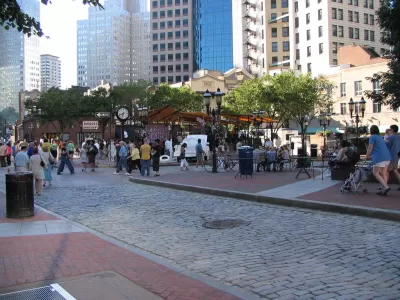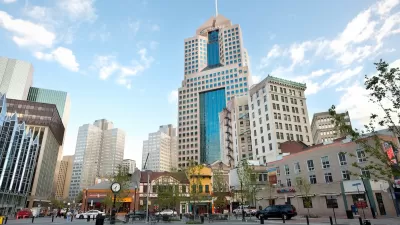Streetsblog recently launched a series that will highlight Pittsburgh as a city "shedding its 'Rust Belt' image and emerging as a leader in progressive street design." The first case study: the city's three shared streets projects.

In anticipation of the Pro Walk/Pro Bike/Pro Place conference in Pittsburgh in September, Streetsblog is "previewing some of the great research and success stories that will be told at the conference," starting with "one type of innovative design that Pittsburgh is increasingly becoming known for: 'shared space.'"
According to Tanya Snyder, who writes the first installment of the series, "[three] recent projects in Pittsburgh have utilized the shared space concept. 'It’s a change in thinking about how that space is used that elevates the status of pedestrians and cyclists — more pedestrians than anyone — over the car,' said Michael Stern, an architect at Strada, the firm that designed the three new shared spaces. 'So that’s a big change.'"
Snyder goes on to provide design and planning details of each of the three shared space projects, as well as the details of the economic development that has followed. For instance: "Market Square, where drug deals used to be conducted in plain view, a major redesign has attracted nearly a billion dollars in new development. In addition to offices surrounding the square, there are almost 500 new residential units and 32 restaurants within a block and a half. Many of the 20 dining establishments that encircle the plaza have patio seating on brick sidewalks that blend into the cobblestone street, with no curb separating them. On the other side of the street, the plaza’s terrazzo floor is also at the same grade."
FULL STORY: Bikes, Cars, and People Co-Exist on Pittsburgh’s Shared Streets

Study: Maui’s Plan to Convert Vacation Rentals to Long-Term Housing Could Cause Nearly $1 Billion Economic Loss
The plan would reduce visitor accommodation by 25,% resulting in 1,900 jobs lost.

North Texas Transit Leaders Tout Benefits of TOD for Growing Region
At a summit focused on transit-oriented development, policymakers discussed how North Texas’ expanded light rail system can serve as a tool for economic growth.

Why Should We Subsidize Public Transportation?
Many public transit agencies face financial stress due to rising costs, declining fare revenue, and declining subsidies. Transit advocates must provide a strong business case for increasing public transit funding.

How to Make US Trains Faster
Changes to boarding platforms and a switch to electric trains could improve U.S. passenger rail service without the added cost of high-speed rail.

Columbia’s Revitalized ‘Loop’ Is a Hub for Local Entrepreneurs
A focus on small businesses is helping a commercial corridor in Columbia, Missouri thrive.

Invasive Insect Threatens Minnesota’s Ash Forests
The Emerald Ash Borer is a rapidly spreading invasive pest threatening Minnesota’s ash trees, and homeowners are encouraged to plant diverse replacement species, avoid moving ash firewood, and monitor for signs of infestation.
Urban Design for Planners 1: Software Tools
This six-course series explores essential urban design concepts using open source software and equips planners with the tools they need to participate fully in the urban design process.
Planning for Universal Design
Learn the tools for implementing Universal Design in planning regulations.
City of Santa Clarita
Ascent Environmental
Institute for Housing and Urban Development Studies (IHS)
City of Grandview
Harvard GSD Executive Education
Toledo-Lucas County Plan Commissions
Salt Lake City
NYU Wagner Graduate School of Public Service




























